
BA-IM-5
Allegra
®
25R Centrifuge
Instruction Manual
®
IMBALANCE
ENTER
PULSE
ACCEL
DECEL
TEMP
RPM
RCF
ROTOR
TIME
STOP
START
FAST
STOP
OPEN
DOOR
SPEED
TIME
TEMP °C
ACC/DEC
Allegra 25R Centrifuge

Symbol
Symbol
Symbole
Símbolo
Title / Titel / Titre / Titulo / Titolo /
Dangerous voltage
Gefährliche elektrische Spannung
Courant haute tension
Voltaje peligroso
Pericolo: alta tensione
Attention, consult accompanying documents
Achtung! Begleitpapiere beachten!
Attention, consulter les documents joints
Atención, consulte los documentos adjuntos
Attenzione: consultare le informazioni allegate
On (power)
Ein (Netzverbindung)
Marche (mise sous tension)
Encendido
Acceso (sotto tensione)
Off (power)
Aus (Netzverbindung)
Arrêt (mise hors tension)
Apagado
Spento (fuori tensione)
Protective earth (ground)
Schutzleiteranschluß
Liaison à la terre
Puesta a tierra de protección
Collegamento di protezione a terra
Earth (ground)
Erde
Terre
Tierra
Scarica a terra
!
/
Simbolo

SAFETY NOTICE
This safety notice summarizes information basic to the safe operation of the equipment
described in this manual. The international symbol displayed above is a reminder that all
safety instructions should be read and understood before installation, operation, mainte-
nance, or repair of this centrifuge. When you see the symbol on other pages, pay special
attention to the safety information presented. Observance of safety precautions will also
help to avoid actions that could damage or adversely affect the performance of the
centrifuge.
Safety During Installation and/or Maintenance
This centrifuge is designed to be installed by a Beckman Coulter Field Service representa-
tive. Installation by anyone other than authorized Beckman Coulter personnel invalidates
any warranty covering the instrument.
This centrifuge weighs 124.0 kg (273.4 lb). Do not attempt to lift or move it without
assistance.
Any servicing of this equipment that requires removal of any covers can expose parts that
involve the risk of electric shock or personal injury. Make sure that the power switch is off
and the centrifuge is disconnected from the main power source, and refer such servicing to
qualified personnel.
Do not replace any centrifuge comonents with parts not specified for use on this instrument.
Electrical Safety
To reduce the risk of electrical shock, this equipment uses a three-wire electrical cord and
plug to connect the centrifuge to earth-ground. To preserve this safety feature:
• Make sure that the matching wall outlet receptacle is properly wired and earth-
grounded. Check that the line voltage agrees with the voltage listed on the name-rating
plate affixed to the centrifuge.
• Never use a three-to-two wire plug adapter.
• Never use a two-wire extension cord or a two-wire non-grounding type of multiple-
outlet receptacle strip.
Do not place containers holding liquid on or near the chamber door. If they spill, liquid
may get into the centrifuge and damage electrical or mechanical components.
Safety Against Risk of Fire
This centrifuge is not designed for use with materials capable of developing flammable or
explosive vapors. Do not centrifuge such materials (such as chloroform or ethyl alcohol)
!

in this centrifuge nor handle or store them within the 30-cm (1-ft) area surrounding the
centrifuge.
Mechanical Safety
For safe operation of the equipment, observe the following:
• Use only the rotors and accessories designed for use in this centrifuge.
• Do not exceed the maximum rated speed of the rotor in use.
• NEVER attempt to slow or stop the rotor by hand.
• Do not lift or move the centrifuge while the rotor is spinning.
• NEVER attempt to override the door interlock system while the rotor is spinning.
• Maintain a 7.6-cm (3-in.) clearance envelope around the centrifuge while it is running.
During operation you should come within the envelope only to adjust instrument
controls, if necessary. Never bring any flammable substances within the 30-cm (1-ft)
area surrounding the centrifuge. Never lean on the centrifuge or place items on the
centrifuge while it is operating.
Chemical and Biological Safety
Normal operation may involve the use of solutions and test samples that are pathogenic,
toxic, or radioactive. Such materials should not be used in this centrifuge, however, unless
all necessary safety precautions are taken.
• Observe all cautionary information printed on the original solution containers prior to
their use.
• Handle body fluids with care because they can transmit disease. No known test offers
complete assurance that they are free of micro-organisms. Some of the most virulent—
Hepatitis (B and C) and HIV (I–V) viruses, atypical mycobacteria, and certain systemic
fungi—further emphasize the need for aerosol protection. Handle other infectious
samples according to good laboratory procedures and methods to prevent spread of
disease. Because spills may generate aerosols, observe proper safety precautions for
aerosol containment. Do not run toxic, pathogenic, or radioactive materials in this
centrifuge without taking appropriate safety precautions. Biosafe containment should
be used when Risk Group II materials (as identified in the World Health Organization
Laboratory Biosafety Manual) are handled; materials of a higher group require more
than one level of protection.
• Dispose of all waste solutions according to appropriate environmental health and safety
guidelines.
It is your responsibility to decontaminate the centrifuge and accessories before
requesting service by Beckman Coulter Field Service.

BA-IM-5
April 2009
© 2009 Beckman Coulter, Inc.
Allegra
®
25R Centrifuge
Instruction Manual
IMBALANCE
ENTER
PULSE
ACCEL
DECEL
TEMP
RPM
RCF
ROTOR
TIME
STOP
START
FAST
STOP
OPEN
DOOR
SPEED
TIME
TEMP °C
ACC/DEC
Allegra 25R Centrifuge


Contents
iii
Page
INTRODUCTION
Certification . . . . . . . . . . . . . . . . . . . . . . . . . . . . . . . . . . . . . . . . . . . . vii
Scope of Manual. . . . . . . . . . . . . . . . . . . . . . . . . . . . . . . . . . . . . . . . . vii
Conventions . . . . . . . . . . . . . . . . . . . . . . . . . . . . . . . . . . . . . . . . . . . . . viii
Notes, Cautions, and Warnings . . . . . . . . . . . . . . . . . . . . . . . . . . . viii
Typographic Conventions . . . . . . . . . . . . . . . . . . . . . . . . . . . . . . . . ix
CFC-Free Centrifugation. . . . . . . . . . . . . . . . . . . . . . . . . . . . . . . . . . . . ix
Radio Interference . . . . . . . . . . . . . . . . . . . . . . . . . . . . . . . . . . . . . . . . . x
Canadian Regulations . . . . . . . . . . . . . . . . . . . . . . . . . . . . . . . . . . . x
Recycling Label . . . . . . . . . . . . . . . . . . . . . . . . . . . . . . . . . . . . . . . . . . . x
SECTION 1: DESCRIPTION
Centrifuge Function and Safety Features . . . . . . . . . . . . . . . . . . . . . . . 1-1
Centrifuge Function . . . . . . . . . . . . . . . . . . . . . . . . . . . . . . . . . . . . 1-1
Safety Features. . . . . . . . . . . . . . . . . . . . . . . . . . . . . . . . . . . . . . . . 1-2
Centrifuge Chassis . . . . . . . . . . . . . . . . . . . . . . . . . . . . . . . . . . . . . . . . 1-3
Housing . . . . . . . . . . . . . . . . . . . . . . . . . . . . . . . . . . . . . . . . . . . . . 1-3
Door . . . . . . . . . . . . . . . . . . . . . . . . . . . . . . . . . . . . . . . . . . . . . . . . 1-3
Rotor Chamber. . . . . . . . . . . . . . . . . . . . . . . . . . . . . . . . . . . . . . . . 1-3
Temperature Sensing and Control . . . . . . . . . . . . . . . . . . . . . . . . . 1-3
Drive . . . . . . . . . . . . . . . . . . . . . . . . . . . . . . . . . . . . . . . . . . . . . . . 1-4
Controls and Indicators . . . . . . . . . . . . . . . . . . . . . . . . . . . . . . . . . . . . 1-4
Power Switch. . . . . . . . . . . . . . . . . . . . . . . . . . . . . . . . . . . . . . . . . 1-4
Control Panel . . . . . . . . . . . . . . . . . . . . . . . . . . . . . . . . . . . . . . . . . 1-4
Name Rating Plate . . . . . . . . . . . . . . . . . . . . . . . . . . . . . . . . . . . . . . . . 1-7
Specifications . . . . . . . . . . . . . . . . . . . . . . . . . . . . . . . . . . . . . . . . . . . . 1-8
Available Rotors. . . . . . . . . . . . . . . . . . . . . . . . . . . . . . . . . . . . . . . . . . 1-9
SECTION 2: PREINSTALLATION REQUIREMENTS
Space and Location Requirements . . . . . . . . . . . . . . . . . . . . . . . . . . . . 2-1
Electrical Requirements . . . . . . . . . . . . . . . . . . . . . . . . . . . . . . . . . . . . 2-2
Transportation Safety Device. . . . . . . . . . . . . . . . . . . . . . . . . . . . . . . . 2-3

iv
Contents
Page
SECTION 3: OPERATION
Summary of Operating Procedures . . . . . . . . . . . . . . . . . . . . . . . . . . . 3-2
Installing the Rotor. . . . . . . . . . . . . . . . . . . . . . . . . . . . . . . . . . . . . . . . 3-3
Setting Run Parameters . . . . . . . . . . . . . . . . . . . . . . . . . . . . . . . . . . . . 3-3
Selecting a Rotor . . . . . . . . . . . . . . . . . . . . . . . . . . . . . . . . . . . . . . 3-3
Setting Run Speed . . . . . . . . . . . . . . . . . . . . . . . . . . . . . . . . . . . . . 3-4
Setting Run Time. . . . . . . . . . . . . . . . . . . . . . . . . . . . . . . . . . . . . . 3-5
Setting Run Temperature. . . . . . . . . . . . . . . . . . . . . . . . . . . . . . . . 3-5
Setting Acceleration and Deceleration Rates . . . . . . . . . . . . . . . . 3-6
Starting a Run. . . . . . . . . . . . . . . . . . . . . . . . . . . . . . . . . . . . . . . . . . . . 3-7
Changing Parameters During a Run. . . . . . . . . . . . . . . . . . . . . . . . . . . 3-8
Stopping a Run . . . . . . . . . . . . . . . . . . . . . . . . . . . . . . . . . . . . . . . . . . . 3-9
SECTION 4: TROUBLESHOOTING
User Messages . . . . . . . . . . . . . . . . . . . . . . . . . . . . . . . . . . . . . . . . . . . 4-1
Other Possible Problems . . . . . . . . . . . . . . . . . . . . . . . . . . . . . . . . . . . 4-3
Retrieving Your Sample in Case of Power Failure . . . . . . . . . . . . . . . 4-4
SECTION 5: CARE AND MAINTENANCE
General Maintenance . . . . . . . . . . . . . . . . . . . . . . . . . . . . . . . . . . . . . . 5-1
Cleaning . . . . . . . . . . . . . . . . . . . . . . . . . . . . . . . . . . . . . . . . . . . . . . . . 5-2
Decontamination . . . . . . . . . . . . . . . . . . . . . . . . . . . . . . . . . . . . . . . . . 5-2
Sterilization and Disinfection. . . . . . . . . . . . . . . . . . . . . . . . . . . . . . . . 5-3
Storage and Transport . . . . . . . . . . . . . . . . . . . . . . . . . . . . . . . . . . . . . 5-3
Supply List . . . . . . . . . . . . . . . . . . . . . . . . . . . . . . . . . . . . . . . . . . . . . . 5-4
Replacement Parts . . . . . . . . . . . . . . . . . . . . . . . . . . . . . . . . . . . . . 5-4
Supplies . . . . . . . . . . . . . . . . . . . . . . . . . . . . . . . . . . . . . . . . . . . . . 5-4
Warranty

v
Contents
Page
Figure 1-1. The Allegra 25R Centrifuge. . . . . . . . . . . . . . . . . . . . . . . . . . . . . . . . . 1-2
Figure 1-2. Control Panel . . . . . . . . . . . . . . . . . . . . . . . . . . . . . . . . . . . . . . . . . . . . 1-4
Figure 2-1. Centrifuge Dimensions. . . . . . . . . . . . . . . . . . . . . . . . . . . . . . . . . . . . . 2-2
Figure 2-2. North American Electrical Socket . . . . . . . . . . . . . . . . . . . . . . . . . . . . 2-3
Figure 4-1. Door Latch Override . . . . . . . . . . . . . . . . . . . . . . . . . . . . . . . . . . . . . . 4-5
Illustrations
Page
Table 3-1. Acceleration and Deceleration Rates (in Minutes:Seconds)
to and from Maximum Speed. . . . . . . . . . . . . . . . . . . . . . . . . . . . . . . . 3-7
Table 4-1. Error Messages. . . . . . . . . . . . . . . . . . . . . . . . . . . . . . . . . . . . . . . . . . . 4-2
Table 4-2. Troubleshooting Chart . . . . . . . . . . . . . . . . . . . . . . . . . . . . . . . . . . . . . 4-3
Tables


Introduction
vii
CERTIFICATION
To ensure full system quality, Beckman Coulter Allegra
®
25R centri-
fuges have been manufactured in a registered ISO 9001 or 13485
facility. They have been designed and tested to be compliant (when
used with Beckman Coulter rotors) with the laboratory equipment
requirements of applicable regulatory agencies. Declarations of
conformity and certificates of compliance are available at
www.beckmancoulter.com.
SCOPE OF MANUAL
This manual is designed to familiarize you with the Beckman Coulter
Allegra 25R centrifuge, its functions, specifications, operation, and
routine operator care and maintenance. We recommend that you read
this entire manual, especially the SAFETY NOTICE and all safety-
related information, before operating the centrifuge or performing
instrument maintenance.
• Section 1 contains system specifications and a brief physical and
functional description of the centrifuge, including the operating
controls and indicators.
• Section 2 provides requirements for preparing laboratory facilities
for the centrifuge.
• Section 3 contains centrifuge operating procedures.
• Section 4 lists possible malfunctions, together with probable
causes and suggested corrective actions.
• Section 5 contains procedures for routine operator care and main-
tenance, as well as a brief list of supplies and replacement parts.

viii
Introduction
NOTE
➠
If the centrifuge is used in a manner other than
specified in this manual, the safety and perfor-
mance of this equipment could be impaired.
Further, the use of any equipment other than
that recommended by Beckman Coulter has not
been evaluated for safety. Use of any equipment
not specifically recommended in this manual
and/or the appropriate rotor manual is the sole
responsibility of the user.
CONVENTIONS
Certain symbols are used in this manual to call out safety-related and
other important information. These international symbols may also be
displayed on the centrifuge and are reproduced and described below
and on the inside of the front cover.
NOTES, CAUTIONS, AND WARNINGS
NOTE
➠
Used to call attention to important information
that should be followed during installation, use,
or servicing of this equipment
!
CAUTION
Used to indicate a potentially hazardous situa-
tion which, if not avoided, may result in minor or
moderate injury and/or mechanical damage. It
is also used to alert against unsafe practices.

ix
Introduction
!
WARNING
Used whenever an action or condition may
potentially cause personal injury or loss of
life. Mechanical damage may also result.
WARNING
Indicates high voltage or risk of electric
shock. Refer servicing of all areas displaying
this symbol to service personnel.
TYPOGRAPHIC CONVENTIONS
Certain typographic conventions are used throughout this manual to
distinguish names of user interface components, such as keys and
displays.
• Key names (for example, [
START] or [ROTOR]) appear in capital
letters within brackets.
• Display names (for example, SPEED or TIME) appear in
bold type.
CFC-FREE CENTRIFUGATION
To ensure minimal environmental impact, no CFCs are used in the
manufacture or operation of Allegra 25R centrifuges.
CFC

x
Introduction
RADIO INTERFERENCE
This equipment has been tested and found to comply with the limits
for a Class A digital device, pursuant to Part 15 of FCC Rules. These
limits are designed to provide reasonable protection against harmful
interference when the equipment is operated in a commercial
environment. This equipment generates, uses, and can radiate radio
frequency energy and, if not installed and used in accordance with
this instruction manual, may cause interference to radio communica-
tions. Operation of this equipment in a residential area is likely to
cause interference, in which case the user will be required to correct
the interference at his own expense.
CANADIAN REGULATIONS
This equipment does not exceed the Class A limits for radio noise
emissions from digital apparatus as set out in the radio interference
regulations of the Canadian Department of Communications.
Le présent appareil numérique n’émet pas de bruits radioélectriques
dépassant les limites applicables aux appareils numériques de Classe
A prescrites dans le reglement sur le brouillage radioelectrique édicté
par le Ministère des Communications du Canada.
RECYCLING LABEL
This symbol is required in accordance with the Waste Electrical and
Electronic Equipment (WEEE) Directive of the European Union. The
presence of this marking on the product indicates:
1) The device was put on the European market after August 13, 2005
and
2) The device is not to be disposed via the municipal waste collection
system of any member state of the European Union.
It is very important that customers understand and follow all laws
regarding the proper decontamination and safe disposal of electrical
equipment. For Beckman Coulter products bearing this label please
contact your dealer or local Beckman Coulter office for details on the
take back program that will facilitate the proper collection, treatment,
recovery, recycling and safe disposal of the device.
A28219-AA
Note: On the instrument, the
triangle background is yellow
rather than gray.

1
Description
1-1
CENTRIFUGE FUNCTION AND SAFETY FEATURES
CENTRIFUGE FUNCTION
The Beckman Coulter Allegra 25R centrifuge (see Figure 1-1) is a
refrigerated benchtop centrifuge that generates centrifugal forces
required for a wide variety of applications. Together with the
Beckman Coulter rotors designed for use in this centrifuge, the
centrifuge applications include:
• Routine processing such as sample preparations, pelleting, extrac-
tions, purifications, concentrations, phase separations, receptor
binding, and column centrifugations.
• Processing large numbers of small-volume samples in multiwell
plates for concentrating tissue-culture cells, cloning and replicate
studies, in-vitro cytotoxicity studies, receptor binding, and genetic
engineering experimentation.
• Rapid sedimentation of protein precipitates, large particles, and
cell debris.
• Binding studies and separation of whole blood.
• Cell isolation.
The Allegra 25R is microprocessor-controlled, providing interactive
operation. The instrument design features a brushless asynchronous
motor, automatic rotor identification system, temperature control
system, and a choice of acceleration and deceleration rates. User
messages alert the operator to conditions that may need attention.

1-2
Description
Figure 1-1. The Allegra 25R Centrifuge
SAFETY FEATURES
The centrifuge has been designed and tested to operate safely indoors
at altitudes up to 2 000 m (6 562 ft). Safety features include the
following.
• An electromechanical door lock system prevents operator contact
with spinning rotors and prevents run initiation unless the door is
shut and locked. The door is locked when a run is in progress and
can be opened only when the rotor is stopped and the LED (light-
emitting diode) on the [
OPEN DOOR] key is lit.
• An imbalance detector monitors the rotor during the run, causing
automatic shutdown if rotor loads are severely out of balance. At
low speeds, an incorrectly loaded rotor can cause imbalance. Rotor
instability can also occur if the centrifuge is moved while running,
or if it is not resting on a level and secure surface.
• To prevent overspeed the microprocessor checks the rotor identifi-
cation during start-up and stops the run if the rotor is incorrectly
identified.
IMBALANCE
ENTER
PULSE
ACCEL
DECEL
TEMP
RPM
RCF
ROTOR
TIME
STOP
START
FAS
T
STOP
OPEN
DOOR
SPEED
TIME
TEMP°C
ACC/DEC

1-3
Description
CENTRIFUGE CHASSIS
HOUSING
The centrifuge housing is made of sheet steel and is finished with
urethane paint. The control panel overlay is made of coated
polycarbonate.
DOOR
The steel door is secured to the housing by solid hinges. When the
door is closed, a motorized locking system engages. The door is
locked when a run is in progress and can be opened only when the
rotor is stopped and the LED on the [
OPEN DOOR] key is lit. If there
is a power failure, the door lock can be manually tripped for sample
recovery (see Section 4, Troubleshooting).
ROTOR CHAMBER
The rotor chamber is stainless steel for durability and corrosion
resistance. The chamber is sealed by a silicone rubber gasket.
TEMPERATURE SENSING AND CONTROL
With the power on, the temperature control system is activated when
the door is closed and locked. Run temperature can be set between
–20 and +40°C. If no set temperature is entered, the instrument auto-
matically selects the last entered temperature.
A sensor in the rotor chamber continuously monitors chamber
temperature. The microprocessor calculates the required chamber
temperature to maintain the selected rotor temperature.
NOTE
➠
To avoid chamber icing, refrigeration is off
when the door is open. The centrifuge door must
be closed and locked for the refrigeration system
to begin operating.

1-4
Description
DRIVE
The asynchronous direct-drive motor is brushless for clean, quiet
operation. A tie-down screw is used to attach the rotor to the drive
shaft. The resilient suspension ensures that loads will not be disturbed
by vibration, and prevents damage to the drive shaft if an imbalance
occurs during centrifugation. Maximum acceleration and deceleration
may be selected to allow fast processing of samples; alternately,
delicate gradients may be preserved using slower acceleration and
deceleration.
CONTROLS AND INDICATORS
POWER SWITCH
The power switch, located on the back panel, controls electrical
power to the centrifuge. It is also a circuit breaker that will trip to cut
off power in the event of a power overload. The power switch must be
turned on before the chamber door can be opened.
CONTROL PANEL
The control panel (see Figure 1-2), mounted at an angle on the
centrifuge front for easy visibility and access, comprises touch
keys—system keys and parameter keys—and digital displays. The
panel also contains an IMBALANCE light that flashes if rotor loads
are severely out of balance.
Figure 1-2. Control Panel
SPEED TIME ACC/DEC
IMBALANCE
ENTER
PULSE
ACCEL
DECEL
TEMPRPM RCF ROTOR TIME
STOP START
FAST
STOP
OPEN
DOOR

1-5
Description
System Keys
Centrifuge operation is controlled through the system keys. Each
key, except [
PULSE], has an LED in the upper left corner that lights
to indicate operational readiness.
[OPEN DOOR] Unlocks the electromechanical door lock. The instrument will not
accept this command if the rotor is spinning.
[FAST STOP] Causes the centrifuge to decelerate to a complete stop at the maxi-
mum rate; deceleration cannot be interrupted—the centrifuge can be
restarted only after the rotor stops and the door is opened and closed.
[STOP] Can be pressed at any time to terminate a run according to the
selected deceleration rate. Deceleration can be terminated and the
centrifuge restarted by pressing [
START] again.
[START] Causes a timed or continuous run to begin; can also be used to abort
deceleration and restart the centrifuge.
[PULSE] Causes the rotor to accelerate to set speed for short-duration runs (as
long as the key is pressed). Deceleration, at maximum rate, begins
when the key is released.
Parameter Keys
These keys are used to set up the run. Except for the cursor and
[
ENTER] keys, parameter keys are located beneath the applicable
digital displays, which show the parameter values as they are input.
Each key (except the cursor keys) has an LED in the upper left corner
that lights to indicate operational readiness. The LEDs also blink if an
incorrect parameter is entered.
[RPM] Causes the last digit in the SPEED display (0) to flash, indicating that
speed can be entered in rpm (revolutions per minute). Corresponding
RCF (relative centrifugal force) is calculated and can be displayed
during the run.
[RCF] Selects speed setting by RCF; the corresponding rpm is automatically
calculated and displayed during the run. If this key is pressed during
the run, the SPEED display shows the RCF value.
[ROTOR] When this key is pressed the number of the rotor used in the previous
run is shown on the SPEED display. The list can be scrolled through,
using the cursor keys, to select a rotor.

1-6
Description
[TIME] Pressed to select the run duration, using the cursor keys.
• Timed run — can be set up to 9 hours, 59 minutes (a minutes
parameter exceeding 59 is automatically converted into hours).
• Continuous run—timer is set for less than 0 or more than 9 hours,
59 minutes (by pressing the down cursor key after the display
reaches 0, or the up cursor key after the display reaches 9:59).
[TEMP] When this key is pressed, the TEMP°C display flashes, indicating
that the temperature can be entered with the cursor keys. Temperature
can be set between –20 and +40°C.
[S] [T] (Cursor Keys) Up and down arrow keys, which can be pressed to increment
parameter values up or down.
[ENTER] Pressed after each parameter is entered to register the entry. Also
pressed to verify parameter changes (speed, time, temperature, and
deceleration rate) made during a run in progress.
[ACCEL] Enables selection of one of 10 preset acceleration rates (see Table 3-1
in Section 3), available to protect specific gradient and sample-to-
gradient interfaces. If no acceleration rate is selected, the centrifuge
defaults to maximum acceleration.
[DECEL] Enables selection of one of 10 preset deceleration rates (see Table 3-1
in Section 3) available to maintain optimum separation. If no deceler-
ation rate is selected, the centrifuge defaults to maximum
deceleration. (Deceleration rate 0 is always coast to complete stop.)
Digital Displays
The displays indicate rotor speed, run time, rotor chamber tempera-
ture, and numbers representing selected acceleration and deceleration
profiles. The displays serve a dual purpose.
• When the run parameters are being entered (input mode), they
show the set values selected. When a parameter key is pressed, the
appropriate display flashes to indicate that data can be entered.
SPEED TIME ACC/DEC
Page is loading ...
Page is loading ...
Page is loading ...
Page is loading ...
Page is loading ...
Page is loading ...
Page is loading ...
Page is loading ...
Page is loading ...
Page is loading ...
Page is loading ...
Page is loading ...
Page is loading ...
Page is loading ...
Page is loading ...
Page is loading ...
Page is loading ...
Page is loading ...
Page is loading ...
Page is loading ...
Page is loading ...
Page is loading ...
Page is loading ...
Page is loading ...
Page is loading ...
Page is loading ...
Page is loading ...
Page is loading ...
Page is loading ...
Page is loading ...
Page is loading ...
Page is loading ...
Page is loading ...
Page is loading ...
Page is loading ...
Page is loading ...
-
 1
1
-
 2
2
-
 3
3
-
 4
4
-
 5
5
-
 6
6
-
 7
7
-
 8
8
-
 9
9
-
 10
10
-
 11
11
-
 12
12
-
 13
13
-
 14
14
-
 15
15
-
 16
16
-
 17
17
-
 18
18
-
 19
19
-
 20
20
-
 21
21
-
 22
22
-
 23
23
-
 24
24
-
 25
25
-
 26
26
-
 27
27
-
 28
28
-
 29
29
-
 30
30
-
 31
31
-
 32
32
-
 33
33
-
 34
34
-
 35
35
-
 36
36
-
 37
37
-
 38
38
-
 39
39
-
 40
40
-
 41
41
-
 42
42
-
 43
43
-
 44
44
-
 45
45
-
 46
46
-
 47
47
-
 48
48
-
 49
49
-
 50
50
-
 51
51
-
 52
52
-
 53
53
-
 54
54
-
 55
55
-
 56
56
Ask a question and I''ll find the answer in the document
Finding information in a document is now easier with AI
Related papers
Other documents
-
Benchmark Scientific BMS-BSC1006-B-E Owner's manual
-
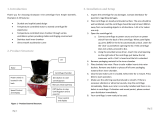 Ample Scientific Champion S-33 User manual
Ample Scientific Champion S-33 User manual
-
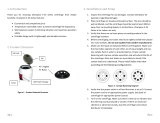 Ample Scientific Champion E-33 Series User manual
Ample Scientific Champion E-33 Series User manual
-
GYROZEN 416 User manual
-
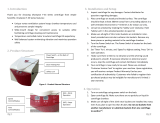 Ample Scientific Champion F-33 Series User manual
Ample Scientific Champion F-33 Series User manual
-
GYROZEN 406 Low Speed Centrifuge User manual
-
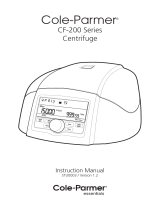 Cole-Parmer CF-200 Stuart Microcentrifuge, 500 to 15,000 rpm; 100 to 240 VAC, 50/60 Hz User manual
Cole-Parmer CF-200 Stuart Microcentrifuge, 500 to 15,000 rpm; 100 to 240 VAC, 50/60 Hz User manual
-
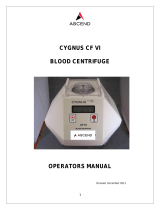 Ascend CYGNUS CF VI User manual
Ascend CYGNUS CF VI User manual
-
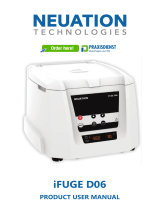 NEUATION TECHNOLOGIES iFuge D06 User manual
NEUATION TECHNOLOGIES iFuge D06 User manual
-
DOMUS 22704 User manual





























































